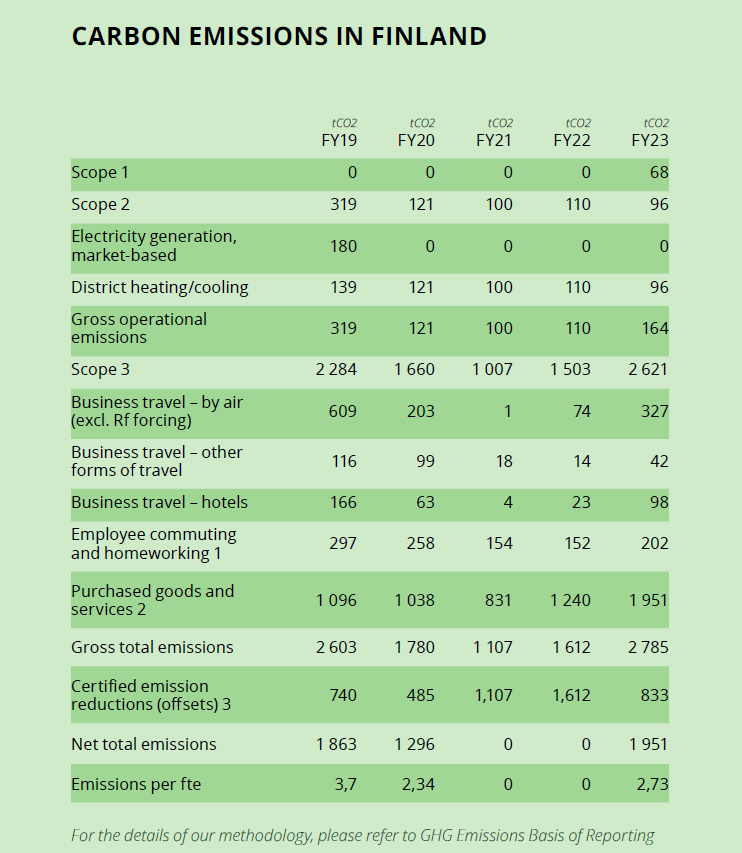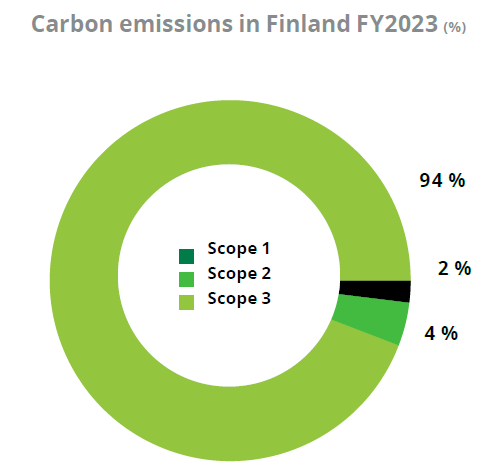In our carbon emissions account, you can find an overview of Deloitte Finland’s carbon emissions divided into Scope 1, 2, and 3 emissions.
This GHG emissions statement has been calculated using an operational control consolidation approach. The full methodology is outlined in the basis of reporting. In summary:
- Scope 1 refers to direct emissions from gas usage and those of our vehicles that are powered by internal combustion engines
- Scope 2 refers to indirect emissions from the generation of our purchased electricity, district heating and cooling, and from our electric vehicles
- Scope 3 includes our emissions from business travel, employees commuting and working from home, and from the goods and services we purchase

Footnote Limited assurance was provided by BDO LLP at a consolidated Deloitte NSE level over all reported carbon metrics. This included consideration of the underlying country data from Belgium, Denmark, Finland, Greece, Iceland, Ireland, Italy, Malta, Middle East, the Netherlands, Norway, Sweden, Switzerland and the UK, plus Jersey, Guernsey, the Isle of Man and Gibraltar.
In the table above, gross total emissions are the sum of market-based electricity data, district heating and business travel data without radiative forcing and purchased goods and services. Location-based electricity data and business travel data with radiative forcing are included in the table to increase the transparency of our reporting.
Purchased goods and services emissions are largely estimated for Finland, relying on extrapolation from procurement spend data obtained from three of our larger NSE Deloitte geographies. For the details of our methodology, please refer to GHG Emissions Basis of Reporting.
Our environmental reporting is an evolving process and we annually review the sources of our emissions to ensure we are painting the full picture. Accordingly, this year we have identified our leased cars in Scope 1 as a source of emissions, something we did not previously report. During FY23 our largest Scope 1, 2, 3 emissions were related to purchased goods and services (PG&S), business travel by air, employee commuting and working from home. Our emissions per FTE were calculated to be 2.73 tCO2. A significant part of our emissions come from our business travel. FY22 was the first year that we also calculated and reported emissions from employees commuting and working from home. Before the Covid-19 pandemic, employees’ commuting and working from home were deemed to fall outside of our operational control and therefore these factors were not reported. Covid-19 has had significant implications for working patterns and, consequently, a hybrid working model became embedded during FY22. This means that we now consider commuting and working from home to be fundamental parts of our operating model, and accordingly, we now purchase offsets/CERs to cover this emissions category and will continue to do so going forward. For transparency and comparability, we have retrospectively calculated emissions in this category and reflected this in the gross and net emissions totals for FY19–FY21. Due to limitations on actual data, it should be noted that a proportion of the calculation of commuting and working from home rests on assumptions and industry benchmarks. We will refine these assumptions and improve the methodology moving forwards as guidelines develop.
The PG&S methodology is largely based on procurement spend data. We apply a number of assumptions to the spending data, including assumptions related to how we allocate spending into procurement categories, how we treat our suppliers’ reported Scope 3 emissions, the sector-based emission factors we apply to each spend category and the extrapolation factors. We continually review our approach to reduce the risks inherent in these assumptions and the impacts of year-on-year fluctuations. In FY23, we revised the methodology for calculating the real estate emissions included in reported PG&S emissions in order to align it with updated guidance from the real estate sector. As a result, we have removed upfront embodied carbon real estate emissions from the reported PG&S emissions. For comparability, this change in methodology has been retrospectively applied to previously reported PG&S amounts, which has resulted in the restatement of PG&S emissions for the base year and all previous years, as shown in this report. The restatement has resulted in emissions decreases of 354 tons in FY22, 458 tons in FY2021, 316 tons in FY2020 and 223 tons in FY2019. Additional details on this restatement are provided in the Basis of Reporting in the Deloitte Global FY23 Impact Report.
We will continue to review our approach to Scope 3 reporting in the future, aiming to continually improve the accuracy of our disclosures. When these enhancements lead to a material change in a reported figure, we are committed to explaining the nature of the change, our reasoning for its appropriateness and the percentage variance compared with previous methodologies.
From FY23 we are taking a new approach to beyond value chain mitigation (BVCM). We are purchasing CERs (carbon offsets) equivalent to our Scopes 1 and 2, business travel, working from home and commuting emissions; we additionally provide direct investment and skills-based support to projects that will drive the net-zero transition outside of our value chain. We are therefore no longer reporting ‘net emissions’ that solely factor in carbon credit purchases.
